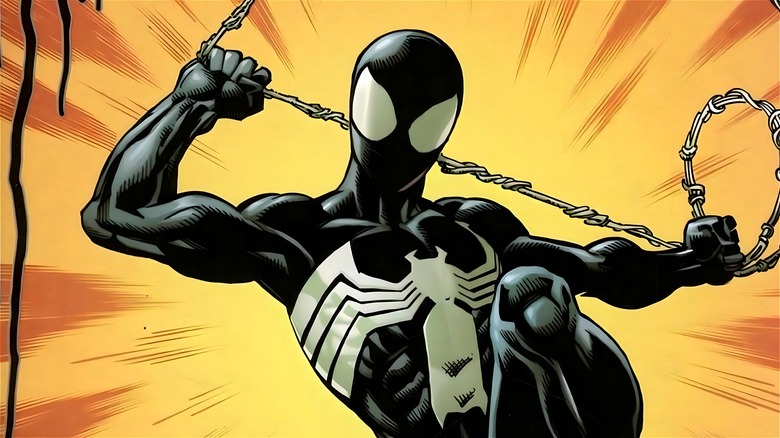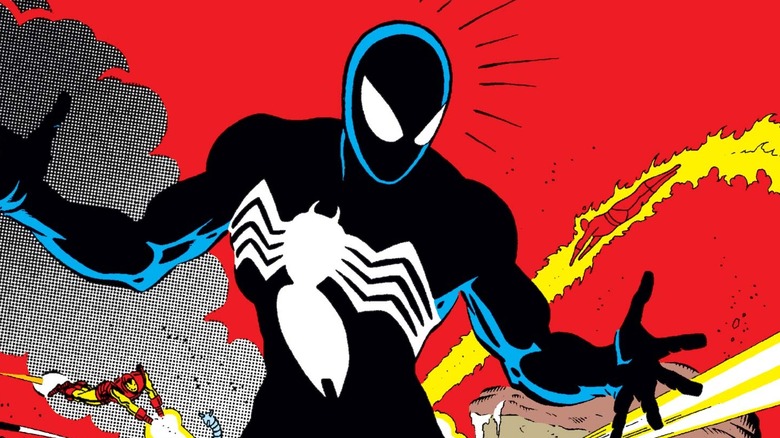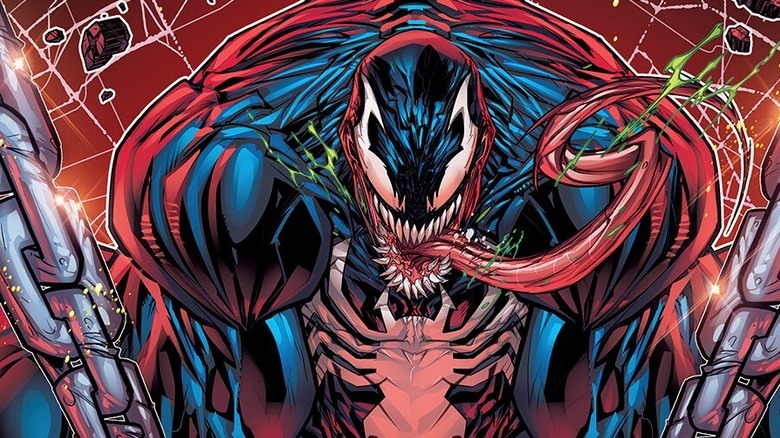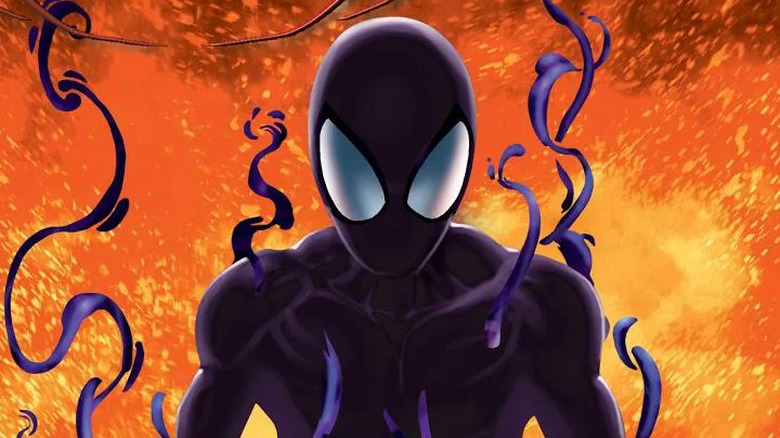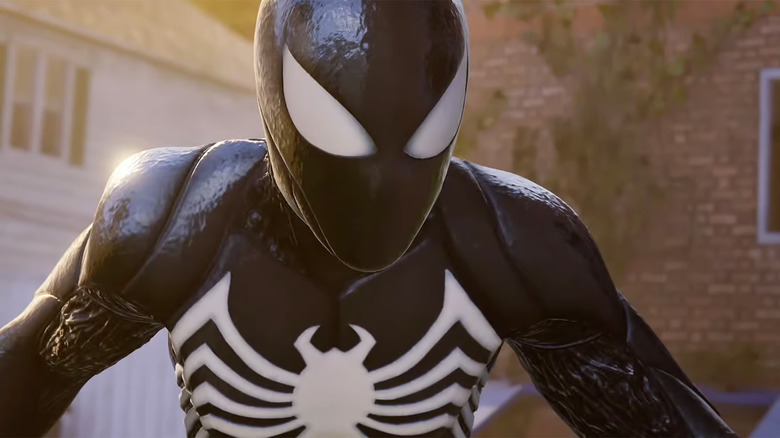How Spider-Man Got The Venom Symbiote Explained
Spider-Man has sported many iconic suits over the years, but few looks are as memorable — and transformative — as his black symbiote costume.
Debuting nearly 40 years ago, the ensuing decades have seen the fan-favorite black suit only become more integral to the Spider-Man mythos. Most recently, the symbiote has played a vital role in the recently released "Marvel's Spider-Man 2" video game, which features a story driven by the arrival of the symbiote and its infection of Peter Parker.
The history of Spider-Man's relationship with Venom is fascinating in its own right, but his time with the black suit — that is, before it grew fangs — is something that almost every web-head media adaptation can't resist tackling at some point, and it's easy to see why. And while we now know the symbiote saga as a pulse-pounding "canon event" where Peter Parker goes down a dark spiral, driven by the suit to engage his worst impulses, the original narrative took much longer to unfold. Here's a deep dive into how Spider-Man first acquired the symbiote, and how subsequent adaptations have tackled the story.
Spider-Man's black suit debuted in Secret Wars
Spider-Man first wore black as part of the massive 1980s crossover "Secret Wars," making a big splash on the cover of #8. The comic book (by Jim Shooter, Mike Zeck, John Beatty, Jack Abel, Mike Esposito, Christie Scheele, and Jon Rosen) sees Spidey — who, along with the other heroes, is trapped on a planet called Battleworld and pitted against an army of bad guys — ruin his costume, whereupon he's directed to a machine that will allegedly create a new costume for him from his thoughts. He chooses the wrong machine, though, and a small black ball appears, that bonds with him and takes the now-iconic shape of the black suit.
Spider-Man doesn't know the suit is alive, but doesn't seem too worried about its material, and so he wears it back home to Earth following the end of the Secret Wars, and he uses it while crimefighting. However, the suit continues influencing his life, even taking him out the window while he's asleep and fighting bad guys with his body, leading Peter to get help from Reed Richards of the Fantastic Four. With Reed's assistance, he discovers the truth — that his "suit" is a living organism trying to permanently attach to Peter's body. He quickly has it removed.
However, the symbiote breaks out. It once again bonds with Peter, and the hero is forced to separate from it by using its weakness — sound waves — against it, via the vibration of giant church bells. The superhero's rejection soon drives the alien into villainy, as it finds a new host.
The symbiote become Venom when it bonds to Eddie Brock
Spider-Man's total rejection of the symbiote results in it bonding with a person who shares its anger at Spider-Man — Daily Globe reporter Eddie Brock, who was fired after misreporting about a serial killer named the Sin-Eater.
Venom arrives in "The Amazing Spider-Man" #300 (by David Michelinie, Todd McFarlane, Bob Sharen, and Rick Parker). While this issue only gave a few basics — namely, that Brock blames Spider-Man for his own downfall, because the webslinger brought in the real Sin-Eater and thus indirectly led to Brock's firing — later retcons also establish that at this same time, Brock divorces his wife and is diagnosed with cancer, making him the perfect host for the vengeful symbiote.
Venom is a ruthless opponent to Spider-Man in his early appearances, but he eventually evolves into an antihero. Over the years, readers would learn more about Venom and the symbiote bonding with him, including its complex history and connection to the ancient God of Symbiotes, Knull. Other humans also become hosts to the Venom symbiote, such as Eddie's son, Dylan, and the former Scorpion, Mac Gargan.
The 1990s Spider-Man: The Animated Series changed the symbiote saga forever
When the 1994 "Spider-Man: The Animated Series" adapted Venom to animation for the first time, it made a few key changes that have influenced every subsequent adaptation to date — and even been retconned into the comics.
In the three-part episode, the symbiote's journey to Peter Parker changed: instead of a machine on Battleworld, it is brought to Earth via the ship of astronaut John Jameson. Spider-Man swoops in to rescue Jameson, and accidentally finds himself bonded to the suit. Rather than the symbiote simply controlling his body while he sleeps, though, the animated series depicts a Peter who is corrupted by its influence — turned aggressive, self-centered, and even murderous.
Thankfully, he detaches himself from the symbiote before any real damage is caused, but this subtle change to the story — that is, Peter going to the dark side — would become a major part of every other telling of the symbiote saga. It was a particularly huge influence on Sam Raimi's "Spider-Man 3," and even the original comics have incorporated it into the narrative. Meanwhile, the cartoon's streamlining of the narrative, with John Jameson bringing the symbiote to Earth, has generally been followed by most adaptations, including 2018's Tom Hardy-starring "Venom" and the later animated series "Spectacular Spider-Man."
Ultimate Spider-Man took a less alien approach to the symbiote saga
In the Ultimate Universe (aka Earth-1610), the Venom symbiote's origin was again changed.
In "Ultimate Spider-Man" #33 (by Brian Michael Bendis, Mark Bagley, Art Thibert, Rodney Ramos, and Transparency Digital), it's revealed Eddie Brock Sr. and Richard Parker once worked together on "Project Venom," an experiment to try to rid the world of cancer. Upon learning about the secret project, Peter Parker tracks down Eddie Brock — here depicted as his childhood best friend — in the present, learning he's continued his late father's experiments in creating "the suit." Peter joins him in continuing his father's legacy, but the suit ends up taking him over, and nearly causing him to eat a man whole. Peter tries to destroy all remains of the suit, earning the rage of Eddie, who uses the one remaining sample to transform himself into Venom.
The "Spectacular Spider-Man" animated series merged elements of the Ultimate origin with the 1990s animated one, but kept the suit alien. However, the 2012 "Ultimate Spider-Man" cartoon went all-in on a synthetic symbiote, this time crafted from Peter's blood by Norman Osborn and Otto Octavius.
How does Peter Parker get the Venom symbiote in the Marvel's Spider-Man 2?
At the end of "Marvel's Spider-Man" on PlayStation 5, gamers learned Norman Osborn had been keeping his sick son, Harry, in stasis, where he was in containment alongside a symbiote.
In the acclaimed game's sequel, "Marvel's Spider-Man 2", the symbiote — also known as VNM-252 — plays a vital role in the storyline. In the game universe, it's revealed that the alien came to Earth on a meteor discovered by Norman Osborn and Curt Connors, and has since been bonded to a comatose Harry Osborn, to prevent his death from a terminal illness. The storyline sees VNM-252 jump from Harry to Peter when the latter is mortally wounded by Kraven the Hunter.
Due to the connection, Peter becomes more and more uncontrollable, and he nearly kills Kraven the Hunter before he's convinced to ditch his symbiote suit. Following this, the symbiote returns to Harry, turning Peter's best friend into Venom. We won't spoil the end of the game, but Venom serves an essential part in the story's conclusion, while helping set up future installments.
How the Venom symbiote could find Spider-Man in the MCU
Now, that leaves us with one big question: how will Tom Holland's Spider-Man cross paths with the Venom symbiote? Because while it obviously will happen, there's a number of routes it could take.
It seems very possible that the upcoming Phase Six crossover "Avengers: Secret Wars" will give its Venom saga a more comics-accurate origin. The story was set up at the end of "Spider-Man: No Way Home," where Eddie Brock accidentally leaves behind a piece of the Venom symbiote before being returned to his world: with the symbiote now existing in the MCU, it stands to reason that will find its way to Peter before either merging with an MCU variant of Brock, or perhaps Mac Gargan.
The seeming inevitability of the MCU Spidey having his own Venom saga, though, proves just how deeply this storyline has become embedded into Spider-Man's mythos as a whole. Ultimately, almost all Spider-Man adaptations feature the Venom symbiote storyline in some form or another. The black suit helps illustrate a much more sinister path Peter could have gone on, and his choosing to abandon the symbiote proves his heroism: with great power comes great responsibility, after all. And with each version of the symbiote saga adding new wrinkles to the story, it'll be exciting to see what path the MCU takes.
